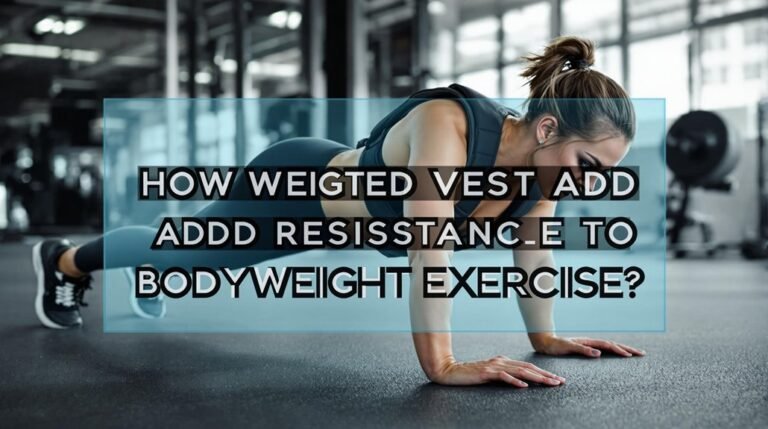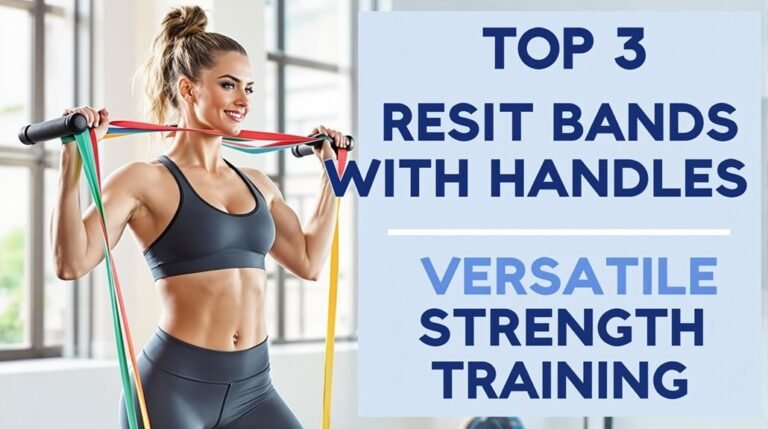Rowing machines are incredibly effective because they engage 86% of your body's muscles in a single workout, combining both cardio and strength training. You'll activate major muscle groups including arms, legs, back, and core while performing low-impact movements that protect your joints. In just 30 minutes, you can burn up to 336 calories (for a 200-pound person), while simultaneously reducing blood pressure and strengthening your heart. The adjustable resistance lets you customize workouts to your fitness level, making it suitable whether you're a beginner or advanced athlete. These extensive benefits explain why rowers have become essential equipment for total-body fitness transformation.
Key Takeaways
- Rowing activates 86% of body muscles in just 15 minutes, engaging arms, legs, back, and core simultaneously.
- Combines cardio and strength training, burning up to 1,150 calories per hour when rowing at 200 watts.
- Low-impact exercise protects joints while providing effective cardiovascular benefits and reducing heart disease risk by 36%.
- Different rowing phases target specific muscle groups, with lower body accounting for 65-75% of the total effort.
- Strengthens heart muscle and improves overall fitness, reducing blood pressure by 9% within six months of regular practice.
The Complete Full-Body Workout
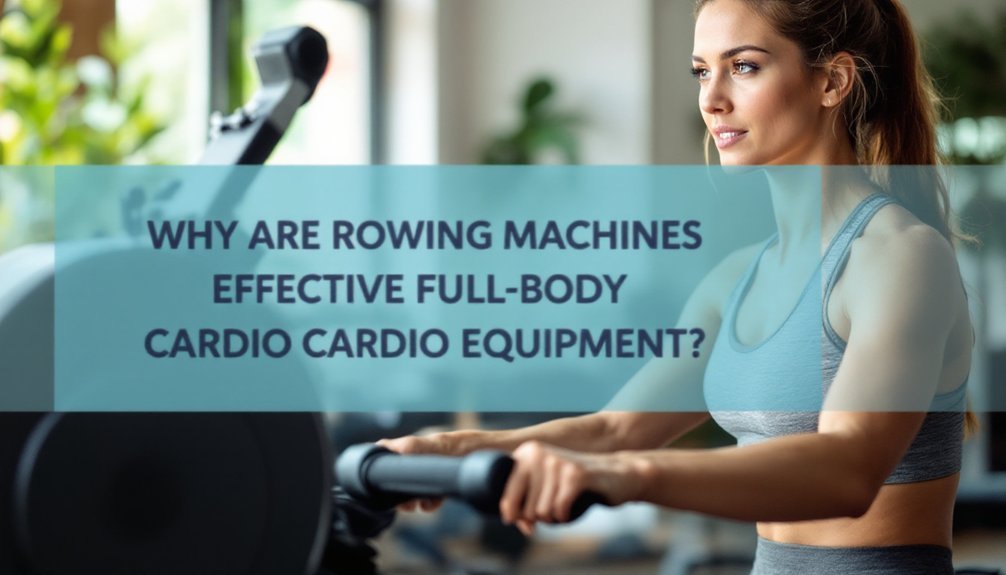
When you step onto a rowing machine, you're engaging in one of the most extensive full-body workouts available. Through proper rowing technique, you'll activate major muscle groups from head to toe, including your arms, legs, back, and core muscles. In just 15 minutes of rowing, you engage 86% of your muscles, making it an incredibly time-efficient exercise choice. Additionally, incorporating heat protectants while exercising can help maintain the health of your hair, especially if you're using techniques that involve heat exposure.
Your workout follows a precise sequence of movements that maximizes full body engagement. During the catch phase, you'll engage your lats and shoulders, while the drive phase activates your legs and back muscles. As you move through the finish phase, your biceps and core take center stage, and the recovery phase brings your hamstrings and triceps into play. Each stroke connects these muscle groups in a fluid motion, creating a thorough workout that strengthens and tones while improving your cardiovascular fitness.
Heart Health and Cardiovascular Benefits
Your blood pressure can see significant improvements through regular rowing, with studies showing decreases of over 9% in both systolic and diastolic readings within just 6 months of training. When you maintain a consistent rowing routine, you're actively strengthening your heart muscle while improving its pumping efficiency, which leads to better circulation throughout your body. Research demonstrates that cholesterol levels decline 3.5% after six weeks of consistent rowing training. Additionally, engaging in regular cardiovascular exercises like rowing can also support gut health by promoting beneficial bacteria growth and enhancing overall wellness. Beyond these immediate benefits, rowing provides long-term protection for your cardiovascular system by reducing your risk of heart disease and lowering mortality rates from heart-related conditions by an impressive 59% compared to non-rowers.
Blood Pressure Impact Benefits
As one of the most effective forms of cardio exercise, rowing offers remarkable benefits for blood pressure control and heart health. Through consistent aerobic exercise on a rowing machine, you'll experience significant reductions in both systolic and diastolic blood pressure, with studies showing decreases of about 9% after six months of training. The superior cardiac load that rowing provides compared to other exercises like cycling makes it particularly effective for cardiovascular conditioning.
| Blood Pressure Impact | Short-Term | Long-Term |
|---|---|---|
| Systolic | Immediate reduction | 9.2% decrease |
| Diastolic | Quick response | 9% decrease |
| Overall Effect | Temporary relief | Sustained improvement |
Your cardiovascular system becomes more efficient with regular rowing, leading to better blood pressure control. The combination of rhythmic movement and full-body engagement helps maintain healthy blood pressure levels, while the low-impact nature of rowing makes it suitable for people of all fitness levels.
Long-Term Heart Protection
Regular rowing machine workouts deliver powerful long-term protection for your heart, backed by impressive statistics showing a 59% lower mortality rate from cardiovascular diseases among dedicated rowers.
When you maintain a consistent rowing routine, you'll experience multiple heart-protecting benefits that build over time. Your risk of developing heart disease drops by 36%, while your cholesterol levels can decrease by 3.5% in just six weeks. This low-impact exercise makes it especially beneficial for maintaining heart health without risking joint strain or injury. You'll also see improvements in your blood pressure, with potential reductions of 9.2% in systolic and 9% in diastolic readings within six months. These changes stem from rowing's ability to strengthen your cardiovascular system, improve blood circulation, and enhance your heart's efficiency in delivering oxygen throughout your body. Additionally, rowing helps reduce body fat and LDL cholesterol, further supporting your long-term heart health.
Low-Impact Exercise for All
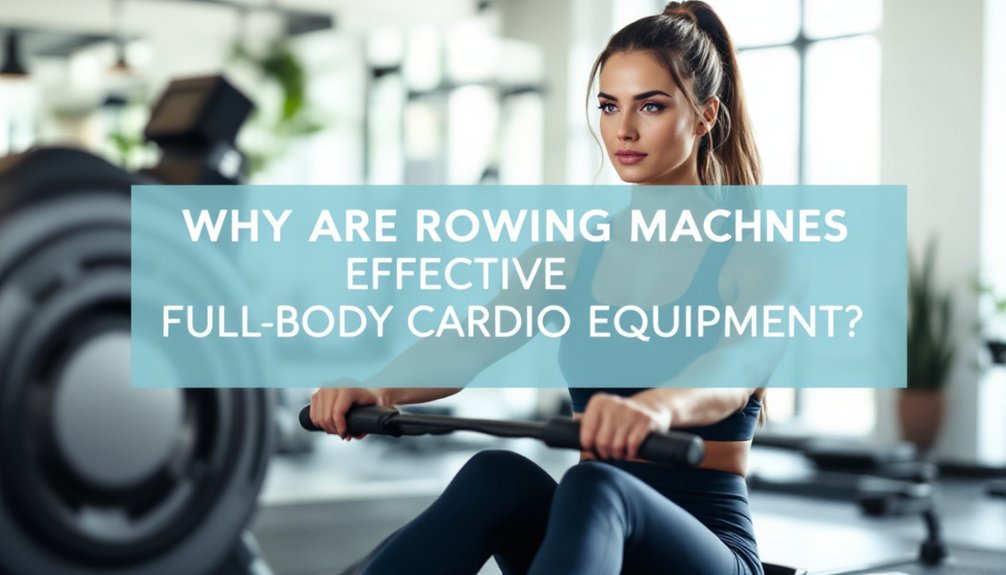
When seeking a thorough workout that's gentle on your joints, rowing machines stand out as an exceptional choice for low-impact exercise. You'll find that rowing supports joint flexibility while providing an effective full-body workout without the harsh impact of activities like running or jumping. It's particularly beneficial for active recovery days when you want to maintain movement without overtaxing your body. Additionally, for those who enjoy outdoor activities, having the right essential gear for running can enhance your overall fitness experience.
Whether you're recovering from an injury, managing joint issues, or simply looking for a sustainable exercise option, rowing machines offer versatility and accessibility. Research shows that rowing is highly effective for VO2 Max improvement, making it an excellent choice for cardiovascular conditioning. You can adjust the resistance and intensity to match your fitness level, making it suitable for beginners and advanced athletes alike. Plus, you'll engage multiple muscle groups while improving your cardiovascular health, all without putting unnecessary stress on your joints.
Efficient Calorie Burning
Rowing machines excel at burning calories through their unique combination of cardio and strength training. You'll experience remarkable calorie efficiency as the machine engages 86% of your muscles with every stroke, making it an excellent choice for weight management and fitness goals. HIIT rowing intervals can maximize your results through the post-workout afterburn effect. Additionally, incorporating compact home gym solutions can enhance your workout experience by providing versatility and convenience.
Your body weight greatly impacts how many calories you'll burn. If you weigh 150 pounds, you can burn about 239 calories in a 30-minute moderate session, while someone weighing 200 pounds burns 336 calories in the same time. By adjusting rowing intensity, you can boost your calorie burn even further. Increasing from moderate to vigorous intensity can enhance calorie burn by up to 33%, and if you're rowing at 200 watts, you could burn up to 1,150 calories per hour, depending on your weight.
Muscle Strength and Endurance
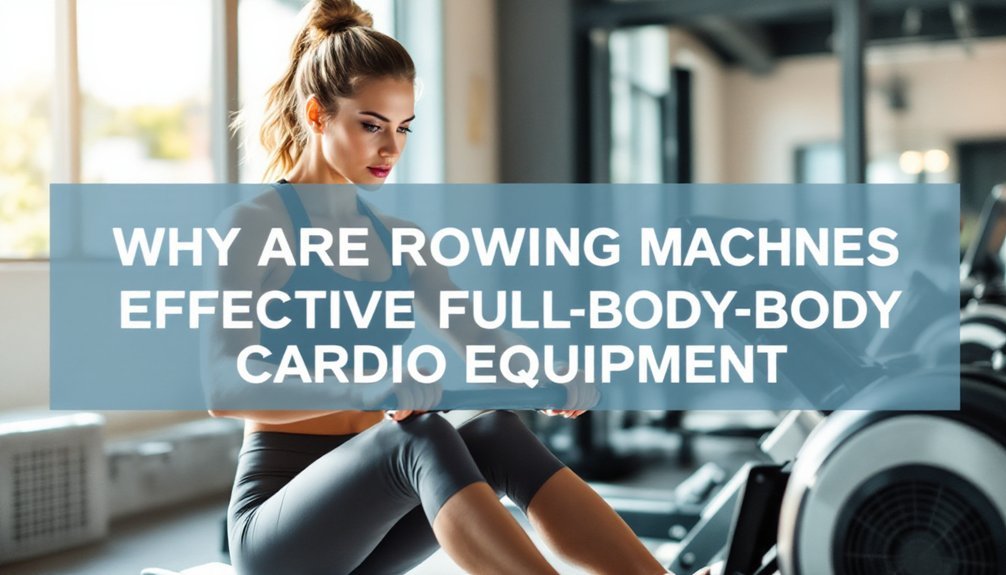
Through its unique full-body motion, a rowing machine builds exceptional muscle strength and endurance by engaging 86% of your body's muscles in a single stroke. Your lower body muscles, including legs and glutes, handle 65-75% of the work, while your upper body manages 25-35% of the rowing movement.
The low-impact nature of rowing provides effective muscle conditioning while minimizing stress on your joints. Additionally, using a fitness tracker during your rowing sessions can help monitor your progress and optimize your workouts.
You'll develop both cardiovascular and muscular endurance as you row, making it an efficient way to combine strength and cardio training. While you won't build massive muscles like with weight training, you'll strengthen major muscle groups throughout your body. Regular rowing also improves muscle recovery between workouts and enhances your overall endurance training capacity. For best results, you can pair your rowing sessions with targeted strength exercises like squats and pull-ups to boost your performance and prevent muscle imbalances.
Multiple Muscle Groups in Action
When you're rowing, your upper body becomes a powerful engine as your lats, deltoids, and pectoral muscles work together to pull the handle smoothly toward your chest. Your core muscles, including your abs and obliques, serve as a vital bridge that transfers energy between your upper and lower body while keeping your spine stable and protected. During each stroke, you'll engage up to 86% of your body's muscles, making rowing one of the most efficient full-body workouts available on any piece of cardio equipment. The drive and finish phases of each rowing stroke maximize muscle engagement by coordinating both upper and lower body movements simultaneously.
Upper Body Power Zones
As you engage in a rowing workout, multiple upper body muscle groups work in synchronized harmony to generate power and maintain proper form. Your biceps and lats drive the pulling motion, while your rhomboids keep your shoulder blades properly positioned. This upper body engagement requires precise muscle coordination to maximize efficiency and prevent injury.
Your upper body contributes 25-35% of your rowing power, making it vital to develop proper strength and technique. You'll want to incorporate specific exercises like push-ups (10-20 reps), pull-ups, and overhead presses to build the necessary muscle groups. These movements strengthen your deltoids and triceps while improving your scapulohumeral rhythm, which is essential for maintaining proper form and preventing common rowing injuries. Regular strength training complements rowing, enhancing overall athletic qualities and ensuring long-term performance improvements.
Total Core Activation
Every rowing stroke engages your entire core system, activating multiple muscle groups simultaneously for maximum efficiency. Your core muscles work as stabilizers, helping transfer power from your legs to your arms while maintaining proper rowing technique throughout each phase of movement. The transverse abdominis stabilizes the spine during each rowing movement to protect against injury.
| Phase | Core Muscles | Primary Function |
|---|---|---|
| Catch | Abdominals | Support Extension |
| Drive | Full Core | Power Transfer |
| Finish | All Core Groups | Stabilization |
| Recovery | Lower Back | Forward Control |
You'll find your core stability improves considerably as you master the rowing motion. During each stroke, your abdominals, obliques, and lower back muscles work together to maintain posture and generate power. This thorough engagement means you're not just getting a cardio workout – you're also strengthening your entire core section, including front, sides, and back muscles simultaneously.
Long-Term Health Advantages
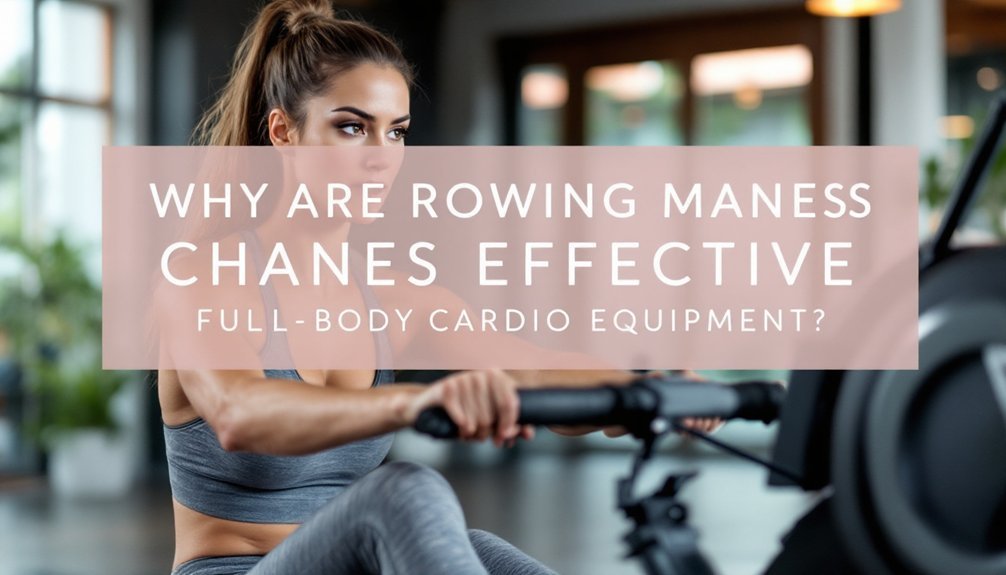
Regular rowing machine workouts deliver remarkable long-term health benefits that'll transform your overall wellness. Your blood glucose levels can drop by 8.5% after just 8 weeks of rowing, making it an excellent choice for diabetes management. You'll also experience improved mental health through stress-reducing, high-intensity sessions.
Here's what consistent rowing can do for your long-term health:
- Lower your mortality rate from cardiovascular diseases by 59%
- Reduce your cholesterol levels by 3.5% and triglycerides by 1.3% in 6 weeks
- Improve your bone density while protecting your joints
With rowing's low-impact nature, you'll strengthen joints by 30% in just 8 weeks while enhancing heart efficiency. Your body will develop better nutrient transport and oxygen delivery to organs, leading to improved overall health and endurance.
Fitness for Every Level
Three key features make rowing machines ideal for fitness enthusiasts at any level. You'll find beginner adaptations that let you start slowly with proper form, while advanced techniques await as your skills improve. The machine's adjustable resistance and stroke rate mean you can progress at your own pace.
| Fitness Level | Recommended Focus | Training Duration |
|---|---|---|
| Beginner | Form and technique | 5-15 minutes |
| Intermediate | Interval training | 15-30 minutes |
| Advanced | HIIT workouts | 30-60 minutes |
Whether you're new to exercise or a seasoned athlete, you can customize your workout intensity through resistance settings and stroke rates. The low-impact nature of rowing makes it accessible even if you have joint concerns, while the potential for high-intensity sessions satisfies advanced athletes seeking challenging workouts.
Home Workout Performance
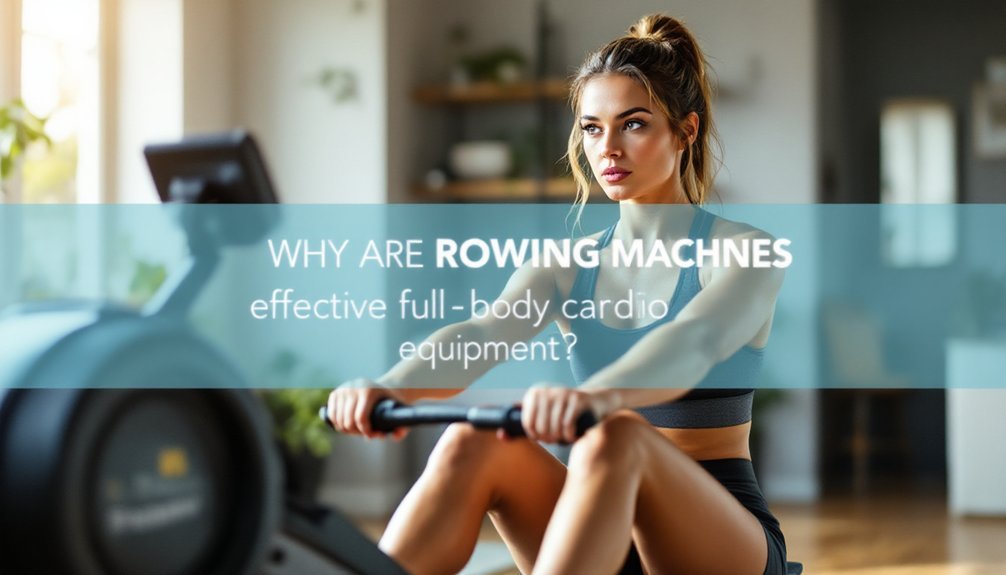
While many cardio machines promise a complete workout, rowing machines deliver exceptional results for home fitness routines. You'll find that incorporating a rowing machine into your home routine offers remarkable flexibility, allowing for effective workouts in as little as 10-15 minutes.
To maximize your exercise motivation and success with rowing at home, consider these key benefits:
- Low-impact workouts that protect your joints while building strength
- Versatile programming options, from gentle cardio to intense HIIT sessions
- Space-efficient design with many models offering folding storage
Your cardiovascular health will improve considerably, with studies showing rowers have a 59% lower mortality rate from heart disease compared to non-rowers. The all-encompassing nature of rowing engages multiple muscle groups simultaneously, making it an efficient choice for your home workout equipment.
Frequently Asked Questions
How Long Should a Beginner Row on a Rowing Machine?
Wondering about beginner workouts? Start with 15-20 minutes to master your rowing technique, then gradually increase by 5-10 minutes as you build confidence and endurance over time.
Can Rowing Machines Help With Back Pain?
Yes, rowing machines can relieve back pain when you use proper rowing technique. They'll strengthen your back muscles, improve posture, and provide low-impact exercise that's gentle on your spine.
Should I Row Every Day or Take Rest Days?
While daily rowing might seem tempting, you shouldn't skip rest days. Start with 2-3 sessions weekly, allowing 48 hours for recovery, then gradually increase frequency as your fitness improves.
Why Do My Feet Keep Slipping off the Rowing Machine?
Your feet may slip due to incorrect foot placement or loose footwear choice. Confirm you've tightened the straps properly, wear snug shoes, and position your feet securely against the footplate.
What Resistance Level Should I Use on a Rowing Machine?
Like finding your perfect rhythm in a dance, set your resistance between 4.5-6.5 to mimic water's drag. You'll maximize resistance benefits while maintaining proper form and technique.


